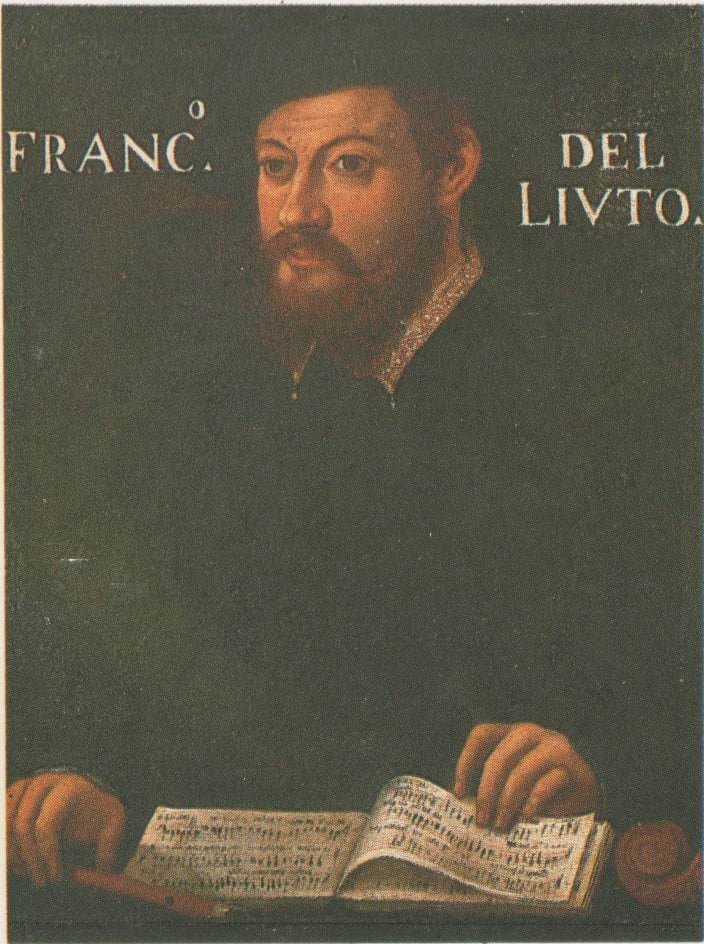Francesco Canova da Milano
Italian composer
Personal Life
Francesco Canova da Milano was born in the Milanese suburb of Monza on August 18, 1497. He moved to Rome in 1519, as a musician to Pope Leo X, where he remained until 1530, working successively for Popes Adrian VI and Clement VII. Francesco then moved to northern Italy and worked as organist in the Duomo of Milan. Before 1535, he was back in Rome working as the lutenist and violist to Cardinal Ippolito de’Medici and as the teacher of Ottavio Farnese, grandson of Pope Paul III. In reference to his extraordinary abilities as a composer, performer and an improviser, Francesco’s contemporaries referred to him as Il Divino. According to Victor Coelho, “Francesco came to represent the Ars Perfecta of lute music, and lutenists took his work to be the standard of excellence.” Lucas Guarico, astrologer to Pope Paul III, wrote that Francesco was “the most eminent musician of all… superior to Orpheus and to Apollo in playing the Lyre and any other instrument whatever.” The exact date of Francesco’s death is uncertain. In his essay, Some Possible Likenesses of Francesco Canova de Milano (1497-1543), the prominent academic H. Colin Slim refers to Francesco’s death as “2 January 1543.” However, in the introduction to The Lute Music of Francesco Canova da Milano (1497-1543), edited by Arthur J. Ness, Francesco’s death appears as of April 15 of 1543. In any case, it is known that at his death, Francesco’s father erected a tombstone in his honor at the church of Santa Maria della Scala, in Milan.
There are in existence a few images thought to depict Francesco. None of these are signed, nor do they contain the exact name of Francesco da Milano. According to scholars such as H. Colin Slim, an anonymous seventeenth century copy of a 16th century painting entitled Francesco del Liuto, is very likely to represent the image of Francesco. Another source for his physical appearance is found as a woodcut in the title page of a book published during Francesco’s lifetime, entitled Intabolatura de liuto de diversi…di M. Francesco da Milano, stampata nuovamente…(Venice: Marcolini, 1536). These possible images of Francesco portrayed him as a bearded, mature man, 35 to 40 years of age, always wearing a small cap.
There are over forty tablature sources of Francesco’s music that were printed in Italy, France, Germany, Spain, Switzerland, and the Lowlands between 1536 and 1603,6 and nearly 25 surviving manuscripts, more than any other lute music composer of the time. Such sources are found in several different forms of tablature writing. An important issue with the performance practice of Francesco’s music is the analysis and removal of extraneous changes that may have been incurred in the process of manuscript copying.
Career
It is impossible to give an overview of Francesco da Milano’s life and work in so few pages, however, it is possible to have a glimpse at how extraordinary they were. Even though quite an interest has been awakened in the study of this magnificent personality, there is still much room and work to be done. The performance of Francesco’s music in modern concert halls is rare and his reputation is not celebrated enough amongst guitarists, lutenists, and other musicians of our present time. Given the stature of his compositions and the tremendous reputation that Francesco da Milano once achieved, to continue the study of his life and bring his music to the modern audience would be the most noble of tasks.
It is a difficult task to accurately reconstruct the life and work of Francesco Canova da Milano (1497-1543), “the most admired lutenist-composer of the early cinquecento… the first native-born Italian composer to receive international renown in the Renaissance.” It is believed that Francesco’s posthumous reputation could have exceeded that of his own lifetime.

Did You Know?
Only a handful of Francesco’s works were published during his life while a much larger number appeared in print after his death.

Francesco Canova da Milano Recordings
Quick Guide...
Music Lessons


